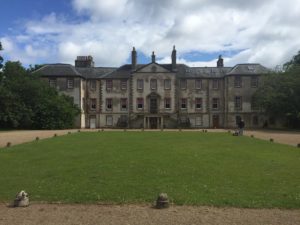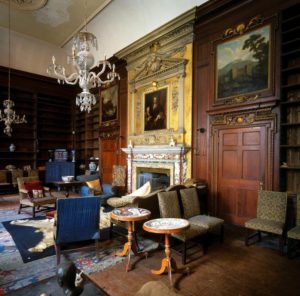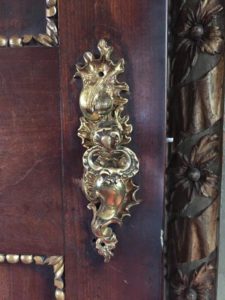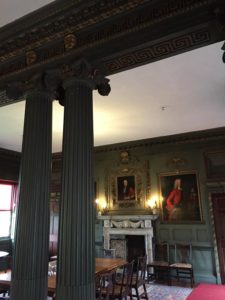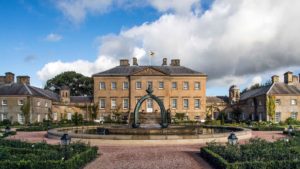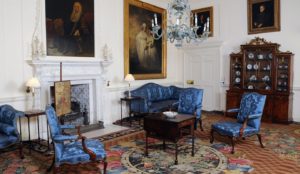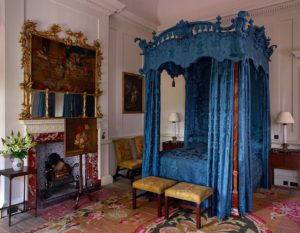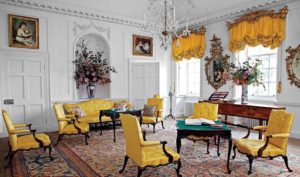A Study in Contrasts: Exploring Newhailes and Dumfries House in Scotland
EVENTS > STUDY TRIPS ABROAD
STUDY TRIP ABROAD 2017 IN REVIEW
Our splendid journey through Scotland, an exercise repeated three times in May and June, was bookended by two noteworthy country houses: Newhailes near Edinburgh and Dumfries House due south of Glasgow. Both are significant structures connected to the famed Adam family dynasty of Scottish architects containing exceptional, well-documented collections.
Descendants were keenly aware of their patrimony’s importance and sought out the opportunity to transfer ownership of into trusts to ensure preservation and public access. Yet, while the two houses are relatively recent additions to the heritage tourism market, we detect few similarities in their presentation on the public stage under the subsequent patronage of the National Trust for Scotland on one hand and that of Prince Charles, or the Duke of Rothesay as he is known in Scotland on the other
Located in Musselburgh, an eastern suburb of Edinburgh, Newhailes was the dwelling of the Dalrymples and their Ferguson descendants from 1709 until the National Trust acquired the property in 1997. The present structure contains a late-17th-century core designed by James Smith encased in additions by a variety of prominent 18th-century architects, most notably William Adam, who completed an earlier double-height library and added a western extension around 1733. Executed on behalf of Sir James Dalrymple, 2nd Baronet of Hailes, Adam’s wing contains impressive interior ornamentation of wood and plaster. These elements were commissioned from a cadre of artisans connected to numerous Adam houses in Scotland, most notably the talented stuccadore Thomas Clayton and carver William Strachan.
James’ son, David Dalrymple, 3rd Baronet, is best remembered as a jurist and historian who authored the two-volume Annals of Scotland (1776, 1779). Dr. Samuel Johnston is said to have described Newhailes’ library as “the most learned drawing room in Europe,” in reference to Dalrymple’s renowned and expansive collection. As such, the house was a center of attraction for many figures involved in the Scottish Enlightenment in the late 18th century.
The National Trust received the house and property in 1997 from Lady Antonia Dalrymple and purchased the contents. The curatorial staff struck a path of dutiful preservation and stabilization that continues to define the visitor’s experience today. Significant resources were invested to ensure the long-term solidity of the structure and the safety of the superlative collection contained therein, with the National Trust stating, “We have carried out as much work as necessary, but as little as possible.” Rather than rushing headlong into a redecoration of the interiors, the Trust has spent the ensuing 20 years connecting the furnishings to a deep documentary record.
The display, therefore, remains a reflection of nearly three centuries of Dalrymple family occupancy, rather than an academic, and admittedly artificial, reinterpretation of the house’s appearance during the 18th-century heydays. While visitors may yearn to see objects returned to the particular rooms for which they were purchased, the presentation is honest and requires us to carefully consider the evolution of Newhailes, the owners’ financial wherewithal, and the house’s varied contents.
The practicality of this approach is easily understood but may evolve into a more hands-on interpretation in the years to come. The room perhaps most deserving of a proactive presentation is the grand library, now entirely bereft of the volumes that elevated the house to such prominence in the late 18th century. This chamber’s forlorn appearance is, however, a powerful reminder of the financial drain of death duties on historic homes held in private hands.
While much further afield from an urban center than Newhailes, Dumfries House rocketed onto the historic preservation scene in 2007, when an imminent sale of the contents by John Crichton-Stuart, 7th Marquess of Bute, was halted by an 11th-hour loan from Prince Charles. The Duke of Rothesay’s involvement is highlighted throughout a visit to Dumfries House, from an introductory video to the private quarters reserved for his use upstairs. Prince Charles graciously made a cameo appearance during our third tour, much to the delight of those participants!
The consortium of benefactors that the Duke assembled to purchase and preserve Dumfries House has taken a decidedly more entrepreneurial approach to their project, a privilege not necessarily available to an institution such as the National Trust. Under the august title of The Great Steward of Scotland’s Dumfries House Trust, the treatment of the house and interiors was not as delicate as at Newhailes, leaning more toward restoration than conservation. The powers that be even added a modern garden and fountain in the forecourt to entice visitors, not to mention a yew hedge maze and “adventure playground” to attract families.
Such efforts have rendered the site a commercially viable enterprise and offer an active backdrop to the stunning and serene rooms within Dumfries House’s handsome-if-understated Palladian exterior, the result of a collaboration between the brothers John and Robert Adam following their father’s death and before the latter left on a Grand Tour. Those interiors are highly regarded for the collections they contain. Dumfries House features Scotland’s most important and extensive collection of documented wares in the rococo manner. Just as Robert Adam was in the early stages his career with this project, so too was Thomas Chippendale, one of the primary cabinetmakers patronized by the builder, William Dalrymple-Crichton, 5th Earl of Dumfries. The famous English wright had recently published his now-famous design book and was a rising star in the field with significant Scottish connections to boot.
Chippendale’s contributions are supplemented by extensive commissions from Edinburgh makers Alexander Peter and Frances Brodie, the most talented Scottish artisans of the period. Peter provided most of the seating furniture, beds, and tables in Dumfries House and drew heavily on Chippendale’s Director for inspiration. Our participants greatly benefitted from the insight of heralded Scottish furniture historian David Jones, who effectively wove the synthesis of the three cabinetmakers’ work throughout the dwelling, a process enabled by the wealth of archival information that survives in the Crichton-Stuart family archive. The significant investment by the Dumfries House Trust in the reupholstery of the beds and seating furniture using reproductions of period fabrics injects fresh color into the thoroughly restored rooms.
Newhailes and Dumfries House should be on every tour itinerary. They represent the pinnacle of high-style achievement in 18th-century Scotland and feature the work of the country’s most talented architects and craftsmen. One is now staid and somber; the other glitz and glamor. The contrast offers an important commentary on the economics of cultural heritage and
the effectiveness of divergent methods of interpretation and preservation.
Complete a digital puzzle from this trip on our Puzzles webpage!

